

Can you solve it? Gems from a mathematical wonderland. Today, three puzzles from Mathigon, a remarkable maths website (about which more later).
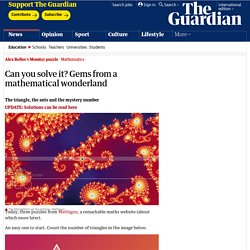
An easy one to start. Count the number of triangles in the image below. Careful though! It’s always easy to miss a few. Talking of (and walking on) triangles…here’s a probability question about random ants. Finally, a very nice logic problem based on arithmetic. Integer means whole number. I’ll be back at 5pm UK time with the answers. UPDATE: Solutions now available to read here. The puzzles – and the illustrations – are taken from Mathigon, a wonderful interactive maths ‘textbook’ that is free online. What’s particularly impressive about Mathigon, however, is that it has been conceived, coded, written and designed by a single person: Philipp Legner, aged 26. Legner studied maths at Cambridge university. Legner has worked as a programmer for Bloomberg and Google but recently left to work on Mathigon full-time.
I set a puzzle here every two weeks on a Monday. Zero: the mind-bendy math behind it, explained. The computer you’re reading this article on right now runs on a binary — strings of zeros and ones. Without zero, modern electronics wouldn’t exist. Math Can’t Solve Everything: Questions We Need To Be Asking Before Deciding an Algorithm is the Answer. Across the globe, algorithms are quietly but increasingly being relied upon to make important decisions that impact our lives.
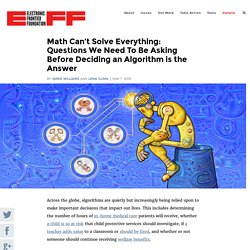
This includes determining the number of hours of in-home medical care patients will receive, whether a child is so at risk that child protective services should investigate, if a teacher adds value to a classroom or should be fired, and whether or not someone should continue receiving welfare benefits. The use of algorithmic decision-making is typically well-intentioned, but it can result in serious unintended consequences. In the hype of trying to figure out if and how they can use an algorithm, organizations often skip over one of the most important questions: will the introduction of the algorithm reduce or reinforce inequity in the system? There are various factors that impact the analysis. Will this algorithm influence—or serve as the basis of—decisions with the potential to negatively impact people’s lives? What is Math? Including a comparison to Science. Philosophy of Numbers - Numberphile. 'Anumeric' people: What happens when a language has no words for numbers?
Numbers do not exist in all cultures.
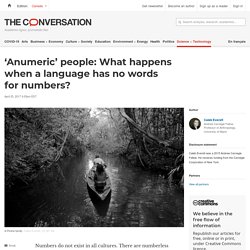
There are numberless hunter-gatherers embedded deep in Amazonia, living along branches of the world’s largest river tree. Instead of using words for precise quantities, these people rely exclusively on terms analogous to “a few” or “some.” In contrast, our own lives are governed by numbers. As you read this, you are likely aware of what time it is, how old you are, your checking account balance, your weight and so on.
The exact (and exacting) numbers we think with impact everything from our schedules to our self-esteem. What is Mathematics? The Most Misunderstood Subject © Dr.
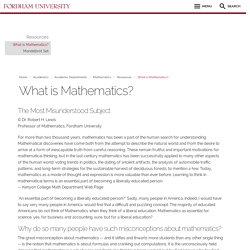
Robert H. LewisProfessor of Mathematics, Fordham University For more than two thousand years, mathematics has been a part of the human search for understanding. Mathematical discoveries have come both from the attempt to describe the natural world and from the desire to arrive at a form of inescapable truth from careful reasoning. The man who taught infinity: how GH Hardy tamed Srinivasa Ramanujan's genius. Throughout the history of mathematics, there has been no one remotely like Srinivasa Ramanujan.

There is no doubt that he was a great mathematician, but had he had simply a good university education and been taught by a good professor in his field, we wouldn’t have a film about him. As the years pass, I admire more and more the astonishing body of work Ramanujan produced in India before he made contact with any top mathematicians. Not because the results he got at the time changed the face of mathematics, far from it, but because, working by himself, he fearlessly attacked many important and some not so important problems in analysis and, especially, number theory – simply for the love of mathematics.
It cannot be understated, however, the role played by Ramanujan’s tutor Godfrey Harold Hardy in his life story. The Cambridge mathematician worked tirelessly with the Indian genius, to tame his creativity within the then current understanding of the field. Determined and obsessed. Theconversation. The Man Who Knew Infinity, now screening in Australian cinemas, presents some of the best descriptions of mathematics yet seen in a film.
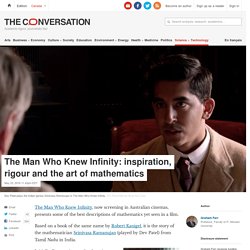
Based on a book of the same name by Robert Kanigel, it is the story of the mathematician Srinivasa Ramanujan (played by Dev Patel) from Tamil Nadu in India. Initially, Ramanujan works alone in Madras, India, self-taught from books but taking his mathematics beyond the frontiers of the field, attributing his inspiration to the Hindu goddess Namagiri. Can mapping conflict data explain, predict and prevent violence? Image copyright Warwick University It was December 2015, and Dr Weisi Guo was having dinner and listening to the grim news about the conflict in Syria.

Over the previous decade, Dr Guo had grown increasingly troubled by the amount of violence towards civilians. He had worked in UNHCR refugee camps in Algeria and seen the human cost at first hand. His own expertise - as an academic specialising in communication networks and telecoms - seemed a world away. But as a physical scientist he wanted a model to help understand the nature of conflict, and so a highly innovative approach began to take shape.
That night he looked at a map of where the Islamic State group was operating and noticed an overlap with locations on the old Silk Road - the route that had taken traders from China through Asia and the Middle East to the Mediterranean thousands of years ago. "What I slowly started to notice was that a lot of these areas prone to repeated violence were along ancient trade routes. 'Choke points' If you can solve one of these 6 major math problems, you'll win a $1 million prize. IMDB / Imagine Entertainment.
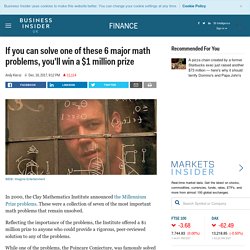
British Man Wins $720,000 For Solving 300-Year-Old Math Problem. In 1993, a cardigan-clad Andrew Wiles delivered the findings of his obsessive seven-year study on “Fermat's Last Theorem” to a lecture at Cambridge University.
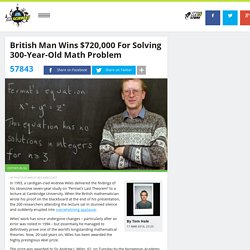
When the British mathematician wrote his proof on the blackboard at the end of his presentation, the 200 researchers attending the lecture sat in stunned silence and suddenly erupted into overwhelming applause. Wiles' work has since undergone changes – particularly after an error was noted in 1994 – but essentially he managed to definitively prove one of the world’s longstanding mathematical theories. Now, 20-odd years on, Wiles has been awarded the highly prestigious Abel prize. The prize was awarded to Sir Andrew J. Wiles, 62, on Tuesday by the Norwegian Academy of Sciences and Letters in Oslo. The mathematical theorem was proposed by Pierre de Fermat in 1637, which states “an + bn = cn. Platonism vs. Formalism. Where do math symbols come from? - John David Walters. An excellent summary of historical information about the origin of many common mathematical symbols is the Wikipedia article on the subject.
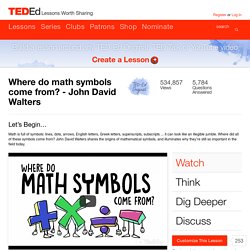
For those who want to dive deeper, the classic study by Florian Cajori is a great source. More information about the life of Robert Recorde can be found at the MacTutor History of Mathematics archive. Part of the inspiration for this lesson came from Richard Feynman’s fascinating anecdote about inventing his own mathematical notation in high school. It is found in one of his essays, titled “He Fixes Radios by Thinking!” Collected in Surely You’re Joking, Mr. A brief history of banned numbers - Alessandra King. Numbers began to emerge together with writing around 5000 BCE as humans developed agriculture and started to live together in larger groups. They needed to know the size of fields, the volume of baskets, the numbers of objects exchanged, and the taxes to be paid, and divisions of land and inheritance.
To make these calculations, they used "counting numbers," or what we call “natural numbers” such as 1, 2, and 3, as well as fractions. When people started thinking about numbers, not just using them, trouble started. Take for example the Pythagoreans, a group of students of mathematics led by the famous mathematician Pythagoras, for whom the Pythagorean theorem is named. For Pythagoras and his followers “all is number.” When Arabic numerals were introduced in Europe, they were received with suspicion, and not just because they were seen as easier to falsify in accounting. Danielle Steel Loves the Weather and Elmore Leonard Hates Exclamation Points: Literature by the Numbers. Ben Blatt's fascinating new book, Nabokov's Favorite Word is Mauve, combines statistical analysis and literature. Using a database of thousands of books and hundreds of millions of words, Blatt answers everything from what are our favorite authors' favorite words to which contemporary writer uses the most clichés to the controversial topic of adverb usage.
How Humans Invented Numbers—And How Numbers Reshaped Our World. Once you learn numbers, it’s hard to unwrap your brain from their embrace. They seem natural, innate, something all humans are born with. Weapons of Math Destruction: Cathy O'Neil adds up the damage of algorithms. “People keep suggesting that democracy is alive and well because we have two parties that don’t agree on everything. I think that’s total bullshit.” When you meet Cathy O’Neil, a data scientist and author, you quickly discover she isn’t exactly convinced about the health of the US’s electoral system. A Harvard PhD graduate in mathematics and actively involved in the Occupy movement, O’Neil’s experience is crucial to her new book: Weapons of Math Destruction describes the way that math can be manipulated by biases and affect every aspect of our lives.
As well as questioning the two-party system in the US, she’s also looked at how mathematics has been used in the housing and banking sector to affect our lives via her blog mathbabe for more than a decade. Literature’s Greatest Opening Lines, as Written By Mathematicians. Is Mathematics Invented or Discovered? Mathematics is the language of science and has enabled mankind to make extraordinary technological advances.
There is no question that the logic and order that underpins mathematics, has served us in describing the patterns and structure we find in nature. Roger Antonsen: Math is the hidden secret to understanding the world. Mathematics Illuminated. Wallpaper Pattern In mathematics, symmetry has more than just a visual or geometric quality. Mathematicians comprehend symmetries as motions—motions whose interactions and overall structure give rise to an important mathematical concept called a "group. " This unit explores Group Theory, the mathematical quantification of symmetry, which is key to understanding how to remove structure from (i.e., shuffle) a deck of cards or to fathom structure in a crystal.
Pollock's Fractals. What are Formal Systems? Introduced here: the MIU puzzle as an example of a formal system. A formal system is composed of axioms, to which rules of inference are applied to produce theorems to which the rules can be applied again. Confused? Try to MIU puzzle yourself – it’s fun! Why the history of maths is also the history of art. When I was a graduate student in art history, I read many explanations of abstract art, but they were invariably inadequate and misleading. Why Pi Matters. The great mystery of mathematics is its lack of mystery. A Cambridge professor on how to stop being so easily manipulated by misleading statistics — Quartz. Did Nate Silver actually get anything wrong about Donald Trump? Photo illustration by Sofya Levina.
Images by Dimitrios Kambouris/Getty Images and Slaven Vlasic/Getty Images. 6 Math Concepts Explained by Knitting and Crochet. This crocheted Lorenz manifold gives insight "into how chaos arises. " Image credit: © Hinke Osinga and Bernd Krauskopf, 2004 Using yarn and two pointy needles (knitting) or one narrow hook (crochet), pretty much anyone can stitch up a piece of fabric. Or, you can take the whole yarncraft thing light-years further to illustrate a slew of mathematical principles. How the Königsberg bridge problem changed mathematics - Dan Van der Vieren. IB Maths Resources from British International School Phuket.
Examples - Proofs without words. Quick Study: Edward Frenkel on math: It's a lot like borscht. Mathematicians dispute claims that the 'golden ratio' is a natural blueprint for beauty - Science - News. Is math discovered or invented? - Jeff Dekofsky. Homer Simpson's scary maths problems. The numbers that keep our world afloat. Do Your Patriotic Duty: Learn Math. Mathematics: Why the brain sees maths as beauty. Is the nature of mathematical proof changing? « Math Drudge. The surprising beauty of mathematics: Jonathan Matte at TEDxGreensFarmsAcademy. Is Math a Feature of the Universe or a Feature of Human Creation? Mathematical equations that changed the world. Ethiopian mathematics. I’ve got a word for Scrabble champions: mathematicians. The golden ratio has spawned a beautiful new curve: the Harriss spiral. Al-Khwarizmi: The father of algebra. Quick Study: Edward Frenkel on math: It's a lot like borscht.
Intuition and math: A powerful correlation. Poincaré on intuition in mathematics. Origami Jumping Frog Instructions. The most random correlations to ever occur. The mathematical secrets of Pascal’s triangle - Wajdi Mohamed Ratemi. TEDxKC - Francis Cholle - The Intuitive Intelligence Movement. Learned Intuition: Patrick Schwerdtfeger at TEDxSacramentoSalon. When intuition and math probably look wrong. Intuition and Mathematics. There’s more to mathematics than rigour and proofs. Mathematical Intuition—What Is It? 1,2,3,4,5,6,7,8,9,10,11,12,13,14,15,16,17,18,19,20,21,22,23,24,25,26,27,28,29,30,31,32,33,34,35...
Nested fish and golden triangles: adult colouring and the beauty of maths.